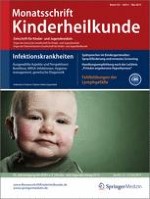Erschienen in:

01.05.2015 | Leitthema
Infektionen mit Methicillin-resistentem Staphylococcus aureus
Prävention und Kontrolle
verfasst von:
T. Dresbach, A. Müller, Prof. Dr. A. Simon
Erschienen in:
Monatsschrift Kinderheilkunde
|
Ausgabe 5/2015
Einloggen, um Zugang zu erhalten
Zusammenfassung
Der Methicillin-resistente Staphylococcus aureus (MRSA) kann auch im Kindesalter bei Patienten mit bestimmten Risikofaktoren als nosokomialer Infektionserreger [“hospital-acquired“ (HA-)MRSA] schwere Infektionen und Infektionsausbrüche verursachen. Hinzu kommen rezidivierende Haut- und Weichteilinfektionen durch ambulant erworbene MRSA-Isolate [“community-acquired“ (CA-)MRSA], die ebenfalls innerhalb der Familie übertragen werden. In dieser Übersicht wird der aktuelle Wissenstand zu Screening, Kontrolle im Krankenhaus und Dekolonisation sowie Antibiotikatherapie bei MRSA-Infektionen diskutiert. In vielen Bereichen gibt es offene Fragen, die weiterer systematisch konzipierter Studien bedürfen.

